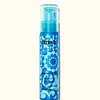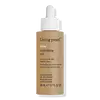What's inside
What's inside
 Key Ingredients
Key Ingredients

 Benefits
Benefits

 Concerns
Concerns

 Ingredients Side-by-side
Ingredients Side-by-side

Prunus Amygdalus Dulcis Oil
Skin ConditioningRicinus Communis Seed Oil
MaskingMangifera Indica Seed Butter
Skin ConditioningSimmondsia Chinensis Seed Oil
EmollientSqualane
EmollientLauryl Laurate
Skin ConditioningArgania Spinosa Kernel Oil
EmollientHippophae Rhamnoides Fruit/Seed Oil
AntimicrobialBrassica Campestris Seed Oil
Skin ConditioningSesamum Indicum Seed Oil
EmollientCocos Nucifera Oil
MaskingSodium Hyaluronate
HumectantSpirulina Platensis Extract
Skin ProtectingEmblica Officinalis Fruit Extract
Skin ConditioningCurcuma Longa Root Extract
MaskingOryza Sativa Bran Extract
Skin ConditioningRosmarinus Officinalis Leaf Extract
AntimicrobialHelianthus Annuus Extract
EmollientGlycerin
HumectantPEG-8 Caprylic/Capric Glycerides
EmulsifyingOctyldodeceth-25
CleansingWater
Skin ConditioningCocos Nucifera Water
MaskingTocopherol
AntioxidantPhenoxyethanol
PreservativePropylene Glycol
HumectantDecylene Glycol
Skin ConditioningParfum
MaskingPrunus Amygdalus Dulcis Oil, Ricinus Communis Seed Oil, Mangifera Indica Seed Butter, Simmondsia Chinensis Seed Oil, Squalane, Lauryl Laurate, Argania Spinosa Kernel Oil, Hippophae Rhamnoides Fruit/Seed Oil, Brassica Campestris Seed Oil, Sesamum Indicum Seed Oil, Cocos Nucifera Oil, Sodium Hyaluronate, Spirulina Platensis Extract, Emblica Officinalis Fruit Extract, Curcuma Longa Root Extract, Oryza Sativa Bran Extract, Rosmarinus Officinalis Leaf Extract, Helianthus Annuus Extract, Glycerin, PEG-8 Caprylic/Capric Glycerides, Octyldodeceth-25, Water, Cocos Nucifera Water, Tocopherol, Phenoxyethanol, Propylene Glycol, Decylene Glycol, Parfum
C13-15 Alkane
SolventIsohexadecane
EmollientIsododecane
EmollientIsoamyl Laurate
EmollientEthylene/Propylene/Styrene Copolymer
C9-12 Alkane
SolventHippophae Rhamnoides Fruit Oil
Skin ProtectingHelianthus Annuus Seed Oil
EmollientCoco-Caprylate/Caprate
EmollientBrassica Campestris/Aleurites Fordi Oil Copolymer
Skin ConditioningCitrullus Lanatus Seed Oil
EmollientMoringa Oleifera Seed Oil
EmollientSimmondsia Chinensis Seed Oil
EmollientOrbignya Oleifera Seed Oil
EmollientPhytosteryl/Octyldodecyl Lauroyl Glutamate
Skin ConditioningButylene/Ethylene/Styrene Copolymer
Amaranthus Caudatus Seed Extract
Skin ConditioningDiisostearyl Malate
EmollientParfum
MaskingCitronellol
PerfumingLimonene
PerfumingCitral
PerfumingLinalool
PerfumingPentaerythrityl Tetra-Di-T-Butyl Hydroxyhydrocinnamate
AntioxidantC13-15 Alkane, Isohexadecane, Isododecane, Isoamyl Laurate, Ethylene/Propylene/Styrene Copolymer, C9-12 Alkane, Hippophae Rhamnoides Fruit Oil, Helianthus Annuus Seed Oil, Coco-Caprylate/Caprate, Brassica Campestris/Aleurites Fordi Oil Copolymer, Citrullus Lanatus Seed Oil, Moringa Oleifera Seed Oil, Simmondsia Chinensis Seed Oil, Orbignya Oleifera Seed Oil, Phytosteryl/Octyldodecyl Lauroyl Glutamate, Butylene/Ethylene/Styrene Copolymer, Amaranthus Caudatus Seed Extract, Diisostearyl Malate, Parfum, Citronellol, Limonene, Citral, Linalool, Pentaerythrityl Tetra-Di-T-Butyl Hydroxyhydrocinnamate
 Reviews
Reviews

Ingredients Explained
These ingredients are found in both products.
Ingredients higher up in an ingredient list are typically present in a larger amount.
Parfum is a catch-all term for an ingredient or more that is used to give a scent to products.
Also called "fragrance", this ingredient can be a blend of hundreds of chemicals or plant oils. This means every product with "fragrance" or "parfum" in the ingredients list is a different mixture.
For instance, Habanolide is a proprietary trade name for a specific aroma chemical. When used as a fragrance ingredient in cosmetics, most aroma chemicals fall under the broad labeling category of “FRAGRANCE” or “PARFUM” according to EU and US regulations.
The term 'parfum' or 'fragrance' is not regulated in many countries. In many cases, it is up to the brand to define this term.
For instance, many brands choose to label themselves as "fragrance-free" because they are not using synthetic fragrances. However, their products may still contain ingredients such as essential oils that are considered a fragrance by INCI standards.
One example is Calendula flower extract. Calendula is an essential oil that still imparts a scent or 'fragrance'.
Depending on the blend, the ingredients in the mixture can cause allergies and sensitivities on the skin. Some ingredients that are known EU allergens include linalool and citronellol.
Parfum can also be used to mask or cover an unpleasant scent.
The bottom line is: not all fragrances/parfum/ingredients are created equally. If you are worried about fragrances, we recommend taking a closer look at an ingredient. And of course, we always recommend speaking with a professional.
Learn more about ParfumThis oil comes from the seeds of the desert shrub called Jojoba. It is more commonly known as jojoba oil, a non-comedogenic oil.
Jojoba oil does not contain fragrance and has many fatty-acids, making it a great soothing ingredient.
It also contains Vitamin E, a great moisturizing ingredient. Vitamin E is also an antioxidant and protects your skin against oxidative damage.
This ingredient humectant properties, meaning it helps draw moisture from the air. This helps keep your skin hydrated.
While jojoba has antibacterial properties, it is only able to kill some strains of bacteria.
Studies also show it helps in wound healing. In fact, Indigenous cultures have used jojoba as a moisturizer and to help treat burns for centuries.
Fun fact: Jojoba oil similar to natural human skin sebum, so it has a great effect on dry skin. It is also promising with helping to regulate sebum production.
Due to its fatty acid content, Jojoba oil may not be fungal acne safe. We recommend speaking with a professional if you have any concerns.
Learn more about Simmondsia Chinensis Seed Oil